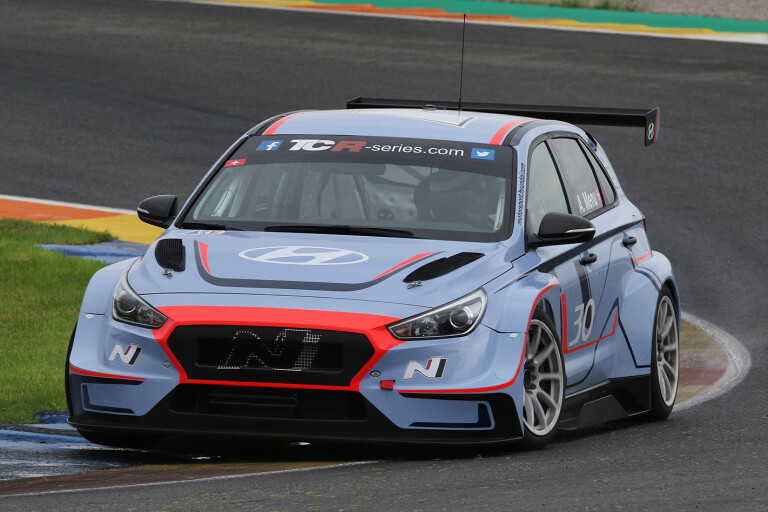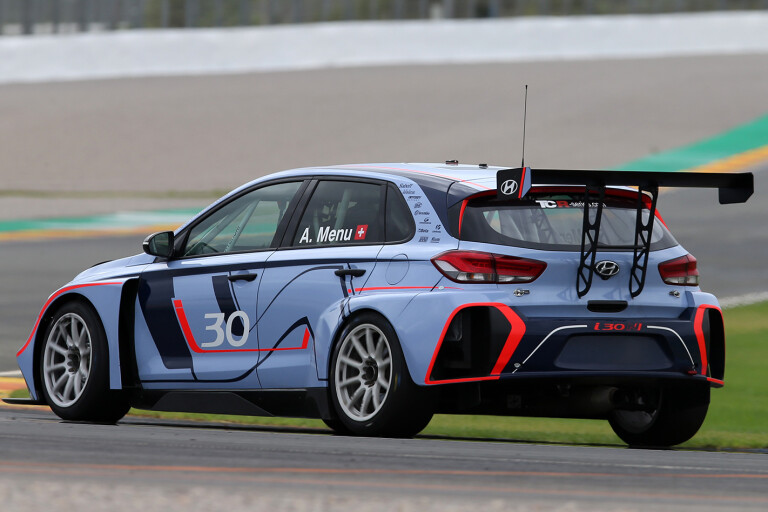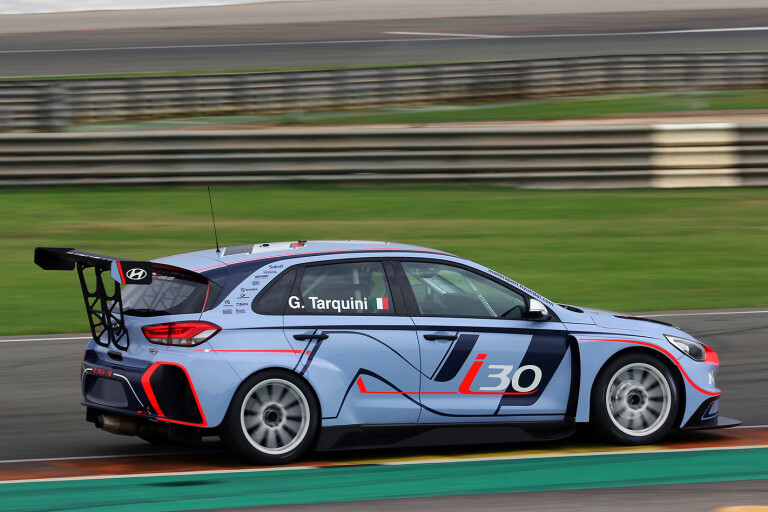
This isn’t your grandma’s Hyundai. The i30 N TCR is a hot hatch turned racer that can best a Porsche GT3 RS on track.
WHAT IS IT?
Capable of shaming its road-car sibling to the tune of 10 seconds a lap, this is the fastest i30 you can buy.

Starting life as a body-in-white i30 chassis that rolls off the production line in Korea, the TCR car is put together in Germany at the hands of the same people responsible for the company’s i20 WRC car.
The engine is production-based, sealed for its 5000km life, and restricted by regulations to 257kW and 460Nm.
Finishing off the road-to-race transformation are beefed up guards, a stripped interior, Michelin slick tyres, and daunting aero additions front and rear.
A local TCR championship is slated to start mid-year, with at least three Hyundais expected to line up on the grid.

WHY WE’RE TESTING IT
We were offered the opportunity to strap into HMO Customer Racing’s brand-new TCR car at Wakefield Park, and weren’t about to say no – what better way to get a feel for a burgeoning racing series than to sit in the hot seat?
The i30 N is our reigning hot hatch champion and we also wanted to see what happens when you try to transform a winning road car formula which requires compromise, into a muscular, single-minded race car.
With this being the chassis’ official shakedown, the pressure was on to ensure everything came back to the pit lane straight and clean. No pressure then.
MAIN RIVALS
Currently 14 manufacturers have cars homologated for TCR globally. The Honda Civic Type R, Alfa Romeo Giulietta Veloce, Volkswagen Golf GTI, and Audi RS3 LMS are all confirmed to compete in the local TCR Australia series.

THE WHEELS REVIEW
DRIVING a racing car is a daunting process. You can’t approach it like a road car that performs at its best early on, with little in the way of warm-up.
A race car requires a lap of purposeful driving to cycle heat into the tyres and brakes, allowing them to perform as intended.
Road cars are also designed to protect the ham-fisted public with expertly calibrated computers able to guide and assist all of your go-fast ambitions – while doing a mightily impressive job of preventing you from careening through a bus-stop.
Not so with a race car that, with a hint of Darwinism, expects a base level of ability to perform at the best of its ability. The driver’s seat of a race car is no place for egotistical antics.
Knowing this, I’m fully expecting the Hyundai i30 N TCR to be a frightening beast to drive. I attempt to mentally prepare myself as I’m strapped into the sparse white cabin.

The ghosts of the TCR’s road-car origins can be seen from the driver’s seat (which is located on the left-hand side), including the wing mirrors and steering column adjuster lifted straight from the i30 you see on the street.
But beyond that, the familiarity well runs dry, with the rest of the cabin decidedly race car. There’s zero sound deadening, and an FIA-spec roll-cage fills much of the space that was once the back seats and boot.
I try not to let the category five hurricane occupying my stomach to burst upwards as I’m backed out of the pit garage. Nathan Morcom, the car’s regular driver, leans into the cabin, presses the ignition, and the 2.0-litre four-cylinder engine fires into life.
This isn’t the refined burble of the i30 N road car, with the noise more akin to what a billion baritone bees might sound like if they were trapped inside a Milo tin.
As the window net is set in place, and driver’s door slammed shut, I’m left on my own. An entire race team watches on as I sit inside their $250,000 car. The ghouls of anxiety that lurk in my mind remind me that it’d be awfully embarrassing to stall in this moment.

Thankfully, the Hyundai i30 N TCR car has a remarkably friendly clutch. Instead of the binary light switch I’m anticipating, it feels much like the road car, but heavier.
Rolling out on track, I spend my first tour attempting to put heat into the 10-inch wide Michelin slick tyres that are placed at each corner with repetitious hard acceleration and braking.
Both upshifts and downshifts are completed without a clutch thanks to the six-speed sequential gearbox and wheel-mounted paddle shifters. It’s incredibly satisfying to bang up the gears, timing shifts with a series of lights which illuminate on a column-mounted display, each change of ratio accompanied by a crisp BANG from the exhaust. Slotting down gears is seamless, the engine matching revs as it changes gears.
Steering the i30 TCR doesn’t require forearms like tree trunks due to an electrical power assisted rack and pinion set-up. With just a single turn lock-to-lock, finesse is a priority when handling the Alcantara-clad steering wheel.
Corner turn-in is potent; thanks to the powerful concoction of slick rubber, clearly functional aerodynamics and a rapid steering rack.

The nose of the car darts towards apexes with ferocious intent, the large front splitter and rear wing keeping the car hunkered down.
I was warned of the car’s propensity to lose rear-end grip before I exited the garage. Thankfully, this only became apparent once during my run, with the rear sliding wide while heading towards the apex of turn two. Swift application of opposite lock prevents an ego-battering rotation as the wide front rubber gripped, a bit of throttle helping to drag me out of the slide.
Powered by a 2.0-litre turbocharged four-cylinder petrol unit that starts life as a road-car engine, the TCR isn’t the most powerful race car around. Its 257kW/460Nm outputs are dwarfed by the likes of Supercars, but represent a healthy boost over the road car’s 202kW and 353Nm.
The added power hasn’t made the engine feel peaky, instead it offers superior low-down pull compared to the road car thanks to the extra 100Nm of torque. Peak power arrives just 200rpm short of the redline, but the power band is wide, allowing the car to pull hard all the way through the rev range.
Acceleration claims are a bit on the nose for a race car, but it’s estimated a TCR car could crack 100km/h from a standstill in approximately 5.2-seconds thanks to a fiendishly complex launch process. My bum dyno tends to believe that estimation, with speed piled on at an impressive pace.
Helping scrub all of that speed off are gargantuan 380mm steel ventilated discs up front, clasped by four-piston calipers, while the rear brakes are 25 percent smaller at 278mm.
There is no anti-lock braking system – or traction control for that matter – which is daunting to discover for the first time as the mechanics are trying to figure out how much circulation they can cut off in my legs while tightening the belts of a six-point racing harness.

To get the most out of the car’s impressive stopping power requires almost all the force I can muster through my leg. Even with the belts fastened to make it feel like my ribs are cracking; a forceful stop feels like the hand of god slapping you on back, forcing me forward in the seat.
Even my most ambitious attempts at stomping the brake pedal can’t cause the front tyres to lock.
Front suspension in Hyundai’s race car is a MacPherson strut set-up, with coil springs and gas-filled dampers, while a four-arm multi-link axle combination underpins the rear.
Ride is, naturally, incredibly stiff. However, even when bashed over sausage kerbs on the apex of corners, the racer remains poised. There is nary a skerrick of secondary movement as the car returns to having all four wheels planted on the asphalt.
While body movement hasn’t been completely expunged from the racer’s character, it is far more restricted than any road car. Lateral roll is near nil, while the most drastic movements are reserved for hard braking, when the nose dives towards the asphalt.
You sit low inside the cabin – practically on the floorpan. This inherently limits outward vision, but since you won’t be encountering any roundabouts in a race car, that’s not necessarily a bad thing.
Wing mirrors are lifted straight from the road car; while an extra-wide rear-vision mirror helps you locate on-track rivals.
Where the seating position does become a hassle though is while attempting to clip ripple strips on corner exit just so.
The electronic dash in front of me, which displays revs, gear selection, and speed for most of the lap, flashes a laptime with every crossing of Wakefield’s start-finish line.
With each tour of the circuit my lap times are shrinking, with multiple seconds being shaved as confidence builds.
That’s the most impressive thing about the Hyundai i30 N TCR car – its ability to allow even the unskilled to extract seriously impressive lap times.
Perhaps that’s not its primary function. After all, when we download the data, Morcom’s an easy six seconds per lap quicker than I am which demonstrates the potential in the chassis, but unlike most race cars, it’s not truculent or intimidating. With the right mindset the i30N TCR is friendly and great fun.
While I won’t be threatening for a race seat any time soon, my final lap in the TCR car is about on par with Warren Luff’s benchmark figure in a Porsche 997 911 GT3. I suspect that could be the only time I’ll be measured in the same league as Motor magazine’s resident hot shoe but I’ll take it.
THE WHEELS VERDICT
There is no denying the i30 N TCR’s race car credentials. Driving it is a brutal and physical experience, but most importantly, it’s quick enough to harass a Porsche Carrera Cup car at the right track.
However, all that speed hasn’t completely killed off the road-car’s approachability. You don’t have to be a professional racing driver to extract impressive lap times out of the i30 N TCR.
With braking akin to a Supercar, and cornering powers not far off a GT3 car, the TCR racer is not to be underestimated.
Even if joining the TCR series wasn’t on your radar, the i30 N racer is a bargain for those with a serious track day fetish. The Porsche GT3 RS, McLaren 600LT or Lamborghini Huracan Performante are all slower around a lap and at least $150,000 more expensive. And the appeal of demolishing these Euro blue-bloods in a four cylinder Hyundai? That’s priceless.
PLUS: Faster than supercars; affordable for a race car; incredible turn-in; forceful braking ability
MINUS: Forward vision means spotting nasty ripple strips is mostly a guessing game; rear grip can be lacking despite massive wing
SPECS
Model: Hyundai i30 N TCR
Engine: 1998cc 4cyl, dohc, 16v, turbo
Max power: 257kW @ 6600rpm
Max torque: 460Nm@ 3200rpm
Transmission: 6-speed X-trac sequential with paddle shift
Weight: 1265kg (including driver)
0-100km/h: 5.2 sec (approx)
Economy: 40L/100km (est)
Price: $250,000
On sale: Now

COMMENTS